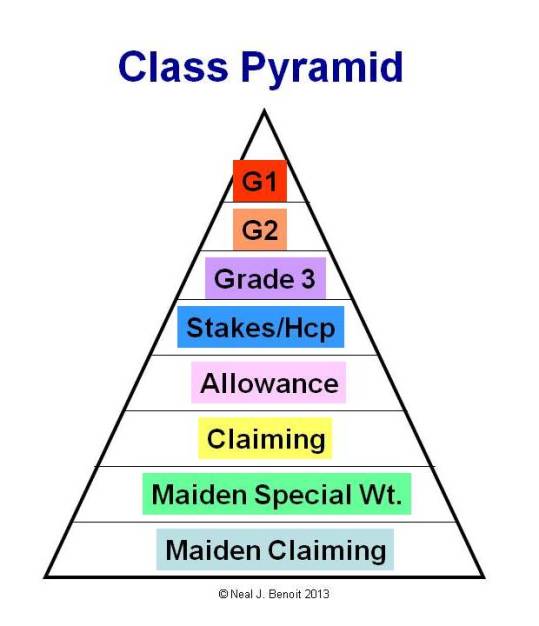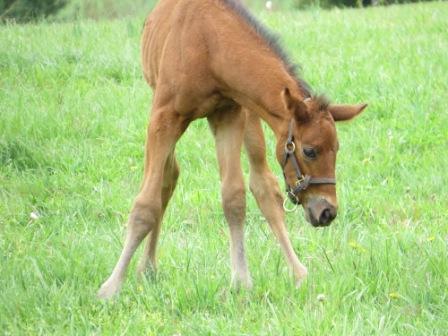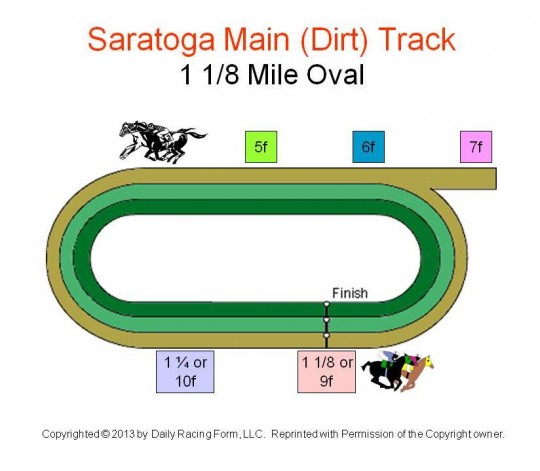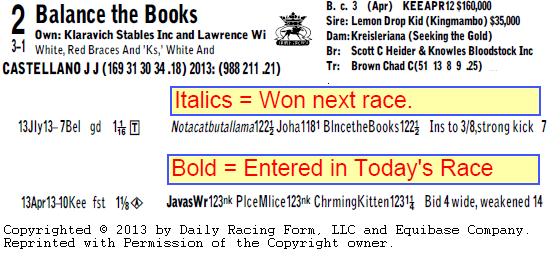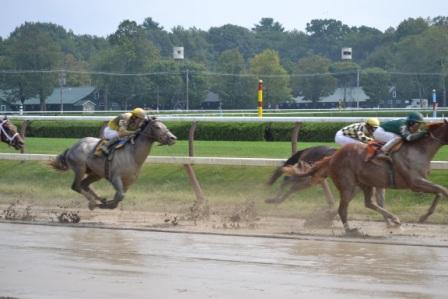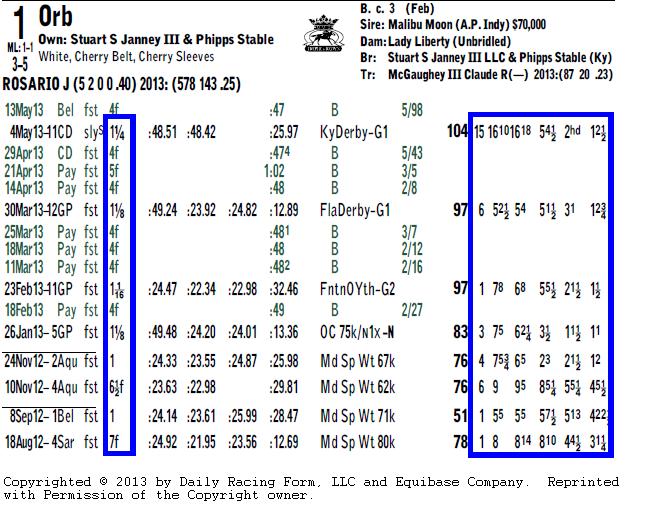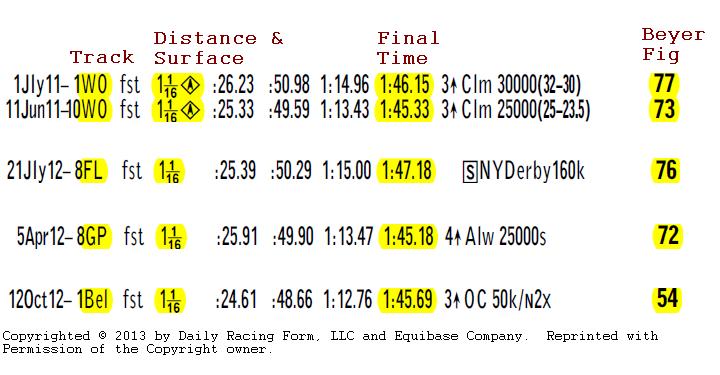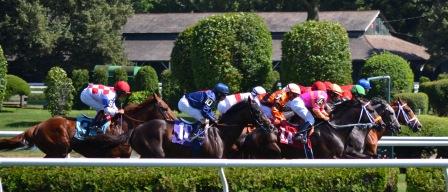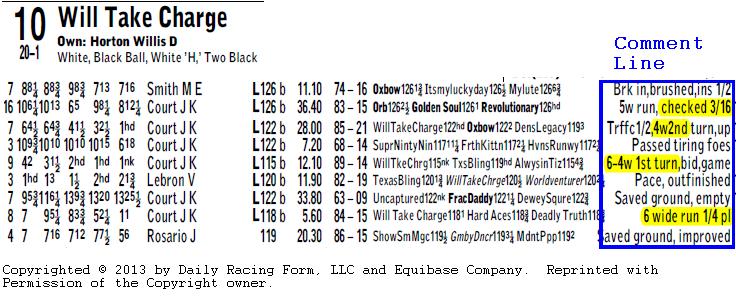Racing 101
Here we introduce the basic building blocks to understanding the sport of horse racing. These are things you need to know, to sound like you are in the know. Click on the title to read the complete article.
What’s a Furlong?
Explains the standard unit of measure for distance in horse racing, the difference between sprints and routes, a quick reference conversion table for distances over 1 mile, and examples of how distance is presented in the running lines of Daily Racing Form.
Also, the past performances of a Kentucky Derby winner are used to demonstrate the typical progression of distances for a stakes caliber horse.
Class Matters – From Top To Bottom
Introduces the topic of Class in horse racing, including an analogy to the various levels of competition in major and minor league baseball.
Using the class pyramid diagram, explains the progression of a horse up and down the different levels of competition, while introducing terms such as “breaking their maiden” and “claiming races.”
Racing Form – The Most Elusive Of Measures
Explains the term Racing Form (Condition, Fitness, Readiness) and why the evaluation of a horse’s form is one of the more challenging aspects of handicapping.
Includes a list of ten criteria to measure a horse’s current form and links to more advanced articles that explain them in greater detail.
Racing Age and Sex
Explains the terminology used to classify horses in terms of their age and sex. Also, describes the restrictions (by age and sex) placed on all thoroughbred races.
Detailed examples are provided with a full explanation of how this information is presented in the Daily Racing Form.
Starting Gate Location Can Make The Same Post Position Good … Or Bad
The position of a horse in the starting gate can be a significant factor in how they perform. Equally important is the location of the starting gate. The two combined, along with a horse’s running style and shape of the race are fully explained.
A diagram of the Saratoga racetrack, along with starting gate positions on the dirt course are provided. Also, an actual race is used to demonstrate this subject, including a video replay for better understanding.
Company Lines
Company Lines provide a snapshot of the top three finishers in a prior race. Additional information is provided, such as lengths beaten and weight carried.
This article provides examples, along with an explanation on how to use this information to determine the quality of competition in a horse’s prior races. Also discussed are the limitations of company lines and alternative ways of getting more complete information from result charts.
Track Conditions
Defines the varying track conditions (e.g. Fast, Firm, Sloppy, etc.) for dirt and turf surfaces, and provides examples of how this information is presented in the Daily Racing Form, including abbreviations and their corresponding meanings.
Also included is an explanation and sample of “sealed” tracks and how they differ from normal “sloppy” tracks.
Running Lines
Running Lines provide a mental image of how a horse ran in a race, by providing the relative position of the horse at various points in the race, starting with the gate break and ending at the finish line.
Here we explain what each position means and provide examples to demonstrate, including the past performances of 2013 Kentucky Derby winner Orb.
Understanding Beyer Speed Figures
Beyer Speed Figures represent a relative measure of how fast a horse finished in a prior race. The higher the number, the faster the horse ran. We explain the relationship between the figures and the final time of a race.
By providing samples from the past performances of horses at multiple tracks, we show how figures are impacted by factors such as track condition, track configurations, and vastly different track surfaces.
Learning About Pace and Moss Pace Figures
Introduces the concept of Pace; its relationship with the various running styles of a horse and how it is defined in the Daily Racing Form with Moss Pace Figures.
Also included is an example of how an extraordinary quick Pace contributed to the failure of Oxbow in the 2013 Kentucky Derby, but a moderately slow pace helped him to win the the 2013 Preakness Stakes.
Explaining Trip Notes
Trip notes are included in the comment section of a horses past performances. They are often utilized by the handicapper to determine if a horse encountered any troubles in a prior race. We provide a list defining some of the most common terms used in trip notes, and a link to a complete list on Equibase.
A Tribute To The Jockey
Pound-for-pound, jockeys are arguably the best athlete in all of sports, and in this article we explain why. Included is a list of the key attributes that distinguish the top jockeys in the sport.
Also, ex-jockey Frankie Lovato adds his own comments on additional characteristics that are important to a jockey.
The Head Trainer – All The Glory, All The Blame
The head trainer is very similar to the head coach for professional sports teams. Ultimately he/she is responsible for everything that happens with a horse while it is in their care.
We describe the role of the trainer, explain the importance of determining their strengths and weaknesses, and offer ways to get further information about trainers.


